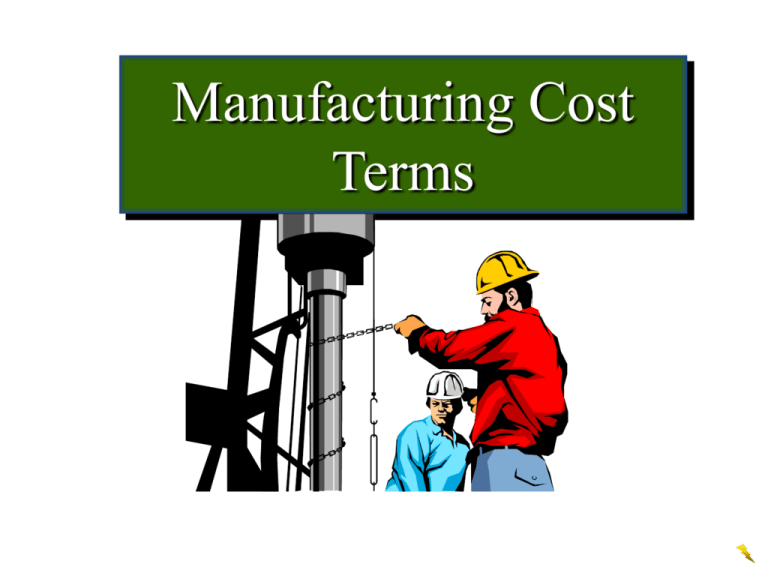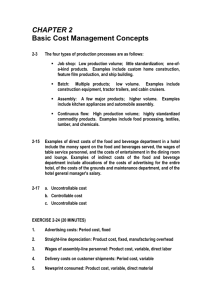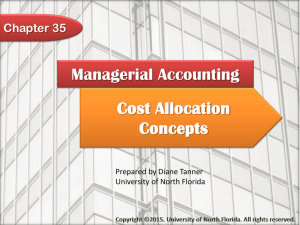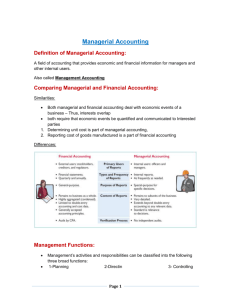Direct Materials are a
advertisement

Manufacturing Cost Terms MATCH TERM & DEFINITIONS Cost Opportunity Cost The return that could not be realized from the best forgone alternative use of a resource A cost charged against revenue Expense Costs not directly related to a cost object Cost Object Any item for which a manager wants to measure a cost Direct Cost Costs directly related to a cost object Indirect Cost A sacrifice of resources THE DEFERENCE of COST and EXPENSE Cost (Harga Pokok) Semua biaya yang telah dikeluarkan dan dianggap masih akan memberi manfaat (benefit) di masa yang akan datang dicatat dalam neraca Expense (Biaya) Semua biaya yang telah dikeluarkan untuk menghasilkan prestasi dan dianggap tidak akan memberikan manfaat (benefit) di masa yang akan datang dicatat dalam perkiraan rugi laba EXPENDITURES, COSTS & EXPENSES • Expenditure – company purchases raw materials for $100 • Cost – company reports $100 of raw materials on balance sheet • Expense – company records $100 expense on income statement when it sells the product that uses the raw material COST EXPENSE ASSET EXPENSE Quick Check Which of the following transactions would immediately result in an expense? (There may be more than one correct answer.) A. Work in process is completed. B. Finished goods are sold. C. Raw materials are placed into production. D. Administrative salaries are accrued and paid. KARAKTERISTIK OPERASI PERUSAHAAN MANUFAKTUR Gudang Barang Pembelian Gudang bahan baku Statemen laba-rugi Barang jadi Penjualan Kos barang terjual Biaya penjualan Bagian Penjualan Biaya administratif Laporan kos produksi Pabrik Bagian Administratif/Umum Kos barang manufakturan MANUFACTURING COSTS Manufacturing consists of activities to convert raw materials into finished goods. In contrast, a merchandising firm sells goods in the form in which they were bought. Categories of manufacturing costs include: Konsep kos sebagai bahan olah akuntansi Aliran fisik Penyimbolan elemen Kas Mesin Bahan baku Utang Tenaga kerja Produk Pengukuran elemen untuk data dasar kos kos kos kos kos kos Sistem informasi Rp1.500.000 Rp750.000 Rp3.500.000 Rp2.500.000 Rp1.750.000 Rp7.500.000 KLASIFIKASI UMUM BIAYA BIAYA PRODUKSI: BB (langsung-tidaklangsung) BTK (langsung-tidaklangsung) BOP BIAYA NON PRODUKSI: Biaya pemasaran atau penjualan Biaya administrasi KOMPONEN KOS PRODUK Overhead Material (bahan baku) Tenaga kerja langsung Direct Materials Direct Labor The Product Manufacturing Overhead DIRECT MATERIALS Those materials that become an integral part of the product and that can be conveniently traced directly to it. Example: A radio installed in an automobile DIRECT LABOR Those labor costs that can be easily traced to individual units of product. Example: Wages paid to automobile assembly workers MANUFACTURING OVERHEAD Manufacturing costs that cannot be traced directly to specific units produced. Examples: Indirect labor and indirect materials Wages paid to employees who are not directly involved in production work. Examples: maintenance workers, janitors and security guards. Materials used to support the production process. Examples: lubricants and cleaning supplies used in the automobile assembly plant. Direct Materials Product Costs Direct Labor Factory Overhead The cost of materials that are an integral part of the product. The cost of labor directly involved in converting material into the product. Manufacturing costs other than direct materials and direct labor. MATERIALS RAW MATERIALS Basic materials used in manufacturing DIRECT MATERIALS Raw materials that can be physically and directly associated with the finished product MATERIALS INDIRECT MATERIALS Raw materials that cannot be easily associated with the finished product Not physically part of the finished product or they are an insignificant part of finished product in terms of cost Considered part of manufacturing overhead LABOR DIRECT LABOR Work of factory employees that can be physically and directly associated with converting raw materials into finished goods INDIRECT LABOR Work of factory employees that has no physical association with the finished product or for which it is impractical to trace to the goods produced MANUFACTURING OVERHEAD Costs that are indirectly associated with manufacturing the product Includes all manufacturing costs except direct materials and direct labor MANUFACTURING COSTS are often classified as follows: Direct Material Direct Labor Prime Cost Manufacturing Overhead Conversion Cost PRIME COSTS Direct Materials + Direct Labor = Prime Costs PRIME COSTS What are the prime costs for Bicycles by the Sea? Direct materials used + Direct labor = $200,000 105,500 $305,000 CONVERSION COSTS Direct Labor + Manufacturing Overhead Indirect Labor Indirect Materials = Other Conversion Costs CONVERSION COSTS What are the conversion costs for Bicycles by the Sea? Direct labor + Indirect manufacturing costs = $105,500 194,500 $300,000 NONMANUFACTURING COSTS Marketing and selling costs . . . –Costs necessary to get the order and deliver the product. Administrative costs . . . –All executive, organizational, and clerical costs. Quick Check Which of the following costs would be considered manufacturing overhead at Boeing? (More than one answer may be correct.) A. Depreciation on factory forklift trucks. B. Sales commissions. C. The cost of a flight recorder in a Boeing 767. D. The wages of a production shift supervisor. PRODUCT COSTS Versus PERIOD COSTS Product costs include direct materials, direct labor, and manufacturing overhead. Cost of Good Sold Inventory Period costs are not included in product costs. They are expensed on the income statement. Expense Sale Balance Sheet Income Statement Income Statement PRODUCT COSTS • What are product costs? –They are the costs to produce (or purchase) tangible products intended for sale. PRODUCT COSTS • There are two types of product costs: Full product costs Inventoriable product costs External Reporting Inventoriable product costs Period costs INVENTORIABLE PRODUCT COSTS • For external reporting, merchandisers’ inventoriable product costs include only costs that are incurred in the purchase of goods. • Inventoriable costs are an asset. • Period costs flow as expenses directly to the income statement. INVENTORIABLE PRODUCT COSTS • For external reporting, manufacturers’ inventoriable product costs include raw materials plus all other costs incurred in the manufacturing process. • Inventoriable product costs are incurred only in the third element of the value chain. • Costs incurred in other elements of the value chain are period costs. INVENTORIABLE PRODUCT COSTS Direct Materials Direct Labor Indirect Labor Indirect Materials Other Manufacturing Overhead INVENTORIABLE PRODUCT COSTS Direct Materials Direct Labor Prime Costs = Direct Materials + Direct Labor INVENTORIABLE PRODUCT COSTS Direct Labor Indirect Labor Indirect Materials Other Conversion Costs = Direct Labor + Manufacturing Overhead The costs of converting the materials into finished products consists of direct labor and factory overhead. These two costs combined are often referred to as conversion costs PERIOD COSTS Matched with revenue of a specific time period and charged to expense as incurred Non-manufacturing costs Deducted from revenues in period incurred to determine net income Includes all selling and administrative expenses EXAMPLES OF PERIOD COSTS SELLING EXPENSES Advertising expenses Sales salaries expenses Commission expenses EXAMPLES OF PERIOD COSTS ADMINISTATIVE EXPENSES Office salaries expenses Office supplies expenses Depreciation expense— office buildings and office equipment LO 4 Distinguish between product costs and period costs. Quick Check Which of the following costs would be considered a period rather than a product cost in a manufacturing company? A. Manufacturing equipment depreciation. B. Property taxes on corporate headquarters. C. Direct materials costs. D. Electrical costs to light the production facility. Review Question Direct Materials are a: Product Cost Manufacturing Overhead Period Cost a. Yes Yes No b. Yes No No c. Yes Yes Yes d. No No No Indicate whether each of the following costs of an automobile manufacturer would be classified as direct materials, direct labor, or manufacturing overhead. ______ DM ______ DM ______ DL ______ MO ______ MO ______ DM ______ DM ______ MO a. b. c. d. e. f. g. h. Windshield Engine Wages of assembly line worker Depreciation of factory machinery Factory machinery lubricants Tires Steering wheel Salary of painting supervisor Identify whether each of the following costs should be classified as product costs or period costs. ____________ Product ____________ Period ____________ Period ____________ Period ____________ Product ____________ Product a. b. c. d. e. f. Manufacturing overhead Selling expenses Administrative expenses Advertising expense Direct labor Direct material COST OBJECTS • Cost objects are anything for which a separate measurement of costs is desired. • Cost drivers are any factors that affect cost. COST OBJECTS • What are examples of cost objects? –individual products –alternative marketing strategies –geographic segments of the business –departments Flow of Manufacturing Costs •Direct Labor •Factory Overhead MATERIALS STOREROOM PRINTING PLANT Job 73 Materials Inventory Work in Process Inventory Flow of Manufacturing Costs WAREHOUSE CAMPUS BOOKSTORE Job 69 Job 70 Finished Goods Inventory Cost of Goods Sold Flow of Manufacturing Costs Materials Materials Purchased DM Work in Process Finished Goods DM Cost of Goods Sold Wages Payable Factory Overhead Total Wages DM Direct materials used in production Flow of Manufacturing Costs Materials Materials Purchased DM Work in Process Finished Goods DM IM Cost of Goods Sold Wages Payable Total Wages IM Factory Overhead IM Indirect materials used in production Flow of Manufacturing Costs Materials Materials Purchased Work in Process DM DM IM DL Finished Goods Cost of Goods Sold Wages Payable Total Wages DL DL Factory Overhead IM Direct labor used in production Flow of Manufacturing Costs Materials Materials Purchased Work in Process DM DM IM DL Finished Goods Cost of Goods Sold Wages Payable Total Wages IL Factory Overhead DL IM IL IL Indirect labor used in production Flow of Manufacturing Costs Materials Materials Purchased Work in Process DM DM IM DL Finished Goods Cost of Goods Sold Wages Payable Total Wages Factory Overhead DL IM IL IL OFOH OFOH Other factory overhead costs incurred during production Flow of Manufacturing Costs Materials Materials Purchased Work in Process DM DM IM DL Finished Goods FOHA Cost of Goods Sold Wages Payable Total Wages Factory Overhead DL IM IL IL OFOH FOHA FOHA Based on predetermined overhead rate Factory overhead applied to work in process Flow of Manufacturing Costs Materials Materials Purchased Work in Process DM DM IM DL COGM Finished Goods COGM FOHA Cost of Goods Sold Wages Payable Total Wages Factory Overhead DL IM IL IL FOHA OFOH COGM Cost of goods manufactured and transferred to finished goods Flow of Manufacturing Costs Materials Materials Purchased Work in Process DM DM IM DL COGM Finished Goods COGM SOLD FOHA Cost of Goods Sold Wages Payable Total Wages Factory Overhead DL IM IL IL FOHA OFOH SOLD Finished goods sold SOLD FLOW of COSTS THROUGH a MANUFACTURER’S ACCOUNTS • Direct Materials Inventory • Beginning inventory + Purchases and freight-in • • + + + = Work in Process Inventory Beginning inventory Direct materials used Direct labor Manufacturing overhead Total manufacturing costs to account for = Direct materials available – Ending inventory for use = Cost of goods – Ending inventory manufactured = Direct materials used FLOW of COSTS THROUGH a MANUFACTURER’S ACCOUNTS • • + = – = Finished Goods Inventory Beginning inventory Cost of goods manufactured Cost of goods available for sale Ending inventory Cost of goods sold DIFFERENTIAL COSTS and REVENUES Costs and revenues that differ among alternatives. Example: You have a job paying $1,500 per month in your hometown. You have a job offer in a neighboring city that pays $2,000 per month. The commuting cost to the city is $300 per month. Differential revenue is: $2,000 – $1,500 = $500 Differential cost is: $300 Quick Check Suppose you are trying to decide whether to drive or take the train to Portland to attend a concert. You have ample cash to do either, but you don’t want to waste money needlessly. Is the cost of the pizza you ate last night relevant in this decision? In other words, should the cost of the pizza affect the decision of whether you drive or take the train to Portland? A. Yes, the cost of the pizza is relevant. B. No, the cost of the pizza is not relevant. Quick Check Suppose you are trying to decide whether to drive or take the train to Portland to attend a concert. You have ample cash to do either, but you don’t want to waste money needlessly. Is the cost of the train ticket relevant in this decision? In other words, should the cost of the train ticket affect the decision of whether you drive or take the train to Portland? A. Yes, the cost of the train ticket is relevant. B. No, the cost of the train ticket is not relevant. NOTE • Every decision involves a choice from among at least two alternatives. • Only those costs and benefits that differ between alternatives (i.e., Differential costs and benefits) are relevant in a decision. All other costs and benefits can and should be ignored. Quick Check Suppose you are trying to decide whether to drive or take the train to Portland to attend a concert. You have ample cash to do either, but you don’t want to waste money needlessly. Is the annual cost of licensing your car relevant in this decision? A. Yes, the licensing cost is relevant. B. No, the licensing cost is not relevant. Quick Check Suppose you are trying to decide whether to drive or take the train to Portland to attend a concert. You have ample cash to do either, but you don’t want to waste money needlessly. Is the depreciation on your car relevant in this decision? A. Yes, the depreciation is relevant. B. No, the depreciation is not relevant. OPPORTUNITY COSTS The potential benefit that is given up when one alternative is selected over another. Example: If you were not attending college, you could be earning $15,000 per year. Your opportunity cost of attending college for one year is $15,000. SUNK COSTS Sunk costs cannot be changed by any decision. They are not differential costs and should be ignored when making decisions Example: You bought an automobile that cost $10,000 two years ago. The $10,000 cost is sunk because whether you drive it, park it, trade it, or sell it, you cannot change the $10,000 cost. Quick Check Suppose that your car could be sold now for $5,000. Is this a sunk cost? A. Yes, it is a sunk cost. B. No, it is not a sunk cost. The End





